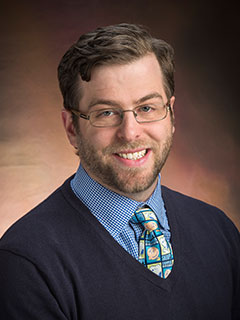HOW CAN WE HELP YOU? Call 1-800-TRY-CHOP
In This Section

Dr. Samelson-Jones is a pediatric hematologist dedicated to improving the lives of children with bleeding and clotting disorders. His research focuses on gene therapy for hemophilia, the biochemical basis of coagulation, and the immune responses to hemophilia therapies.
Bio
Dr. Samelson-Jones is a pediatric hematologist dedicated to improving the lives of children with bleeding and clotting disorders. He received his doctorate training in protein biophysics at Albert Einstein College of Medicine where he provided the first molecular description of the interaction between nitric oxide and indoleamine 2,3-dioxygenase, a critical enzyme in immune tolerance. He completed clinical training at the Children’s National Medical Center and Children’s Hospital of Philadelphia.
His research at CHOP helped establish the gain-of-function coagulation factor IX variant Padua as the standard transgene for gene therapy for hemophilia B. He was the first to characterize the biochemical basis of the hyperactivity of factor IX Padua, and he helped run the first successful clinical gene therapy trial using factor IX Padua. The first regulatory approved gene therapeutics for hemophilia B are anticipated to use factor IX Padua.
Dr. Samelson-Jones has also studied other approaches to improve gene therapy for hemophilia. He delineated a deleterious interaction between the intracellular protease furin and coagulation factor VIII and demonstrated that bioengineering factor VIII to avoid furin improves gene therapy for hemophilia A. He has also investigated the consequences of immunosuppression on adeno associated viral vector gene therapy and established that concomitant intensive T cell directed immunosuppression and vector administration increases the risk of immune complications.
Education and Training
BA, Amherst College (Physics), 2001
MD, Albert Einstein College of Medicine, 2009
PhD, Albert Einstein College of Medicine (Biophysics), 2009
Pediatric Residency, Children's National Medical Center, 2012
Hematology and Oncology Fellowship, Children's Hospital of Philadelphia, 2015
Titles and Academic Titles
Assistant Professor, Perelman School of Medicine at the University of Pennsylvania
Member, The Raymond G. Perelman Center for Cellular and Molecular Therapeutics (CCMT), University of Pennsylvania School of Medicine
Associate Director, Clinical In Vivo Gene Therapy, Children's Hospital of Philadelphia
Professional Memberships
Phi Beta Kappa
Sigma Xi
American Academy of Pediatrics
American Society of Hematology
American Society of Pediatric Hematology and Oncology
The American Board of Pediatrics
Hemostasis and Thrombosis Research Society
International Society of Thrombosis and Haemostasis
American Society of Gene and Cell Therapy
The American Board of Pediatrics and its Sub-board of Pediatric Hematology-Oncology
Professional Awards
The Basset Physics Prize, 1999
Dean of Faculty Fellowship for Student Research, 2000
The William Warren Stifler Physics Prize, 2001
Society of Porphyrins and Phthalocyanines Student Assistance Grant, 2006
Medical Student Teaching Award, 2011
Thrombosis-Hemostasis Summit of North America (THSNA) Travel Award, 2014
Children’s Hospital of Philadelphia Research Poster Day Prize, 2015
Outstanding Poster Presentation Award, American Society of Gene and Cell Therapy, 2018
Thrombosis-Hemostasis Summit of North America (THSNA) Young Investigator Award, 2020
Distinguished Teaching Award for Hematology, Children's Hospital of Philadelphia, 2021
Association for the Advancement of Blood and Biotherapies (AABB) Scholar Award, 2022
Publication Highlights
Active Grants/Contracts
Translating mechanistic insights into Intrinsic Xase function
NIH/NHLBI
2024-2029
The goal of this work is to elucidate the molecular interactions and assembly of the intrinsic Xase complex and develop new therapies for hemophilia A, hemophilia B, and factor X deficiency. Novel therapeutic approaches being explored include gene transfer and repurposing bispecific antibodies.
Immune tolerance induction by AAV-FVIII gene therapy for canine hemophilia A with inhibitors
NIH/NHLBI
2021-2026
The overall goal of this proposal is to use AAV liver gene therapy for the treatment of hemophilia A complicated by inhibitory antibodies to FVIII using novel high inhibitor risk canine models of hemophilia A. Unique to this approach is that after eradication of inhibitors and induction of immune tolerance, AAV-mediated continuous expression of the FVIII will improve the disease bleeding phenotype. Thus, the success of this approach will impact other diseases complicated by the antibodies to the therapeutic protein.